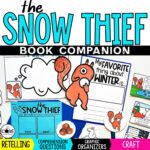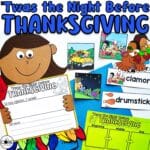If you are an elementary school teacher, then you probably already do some type of reading activity with your students. Most likely, if you are teaching first or second graders, this includes weekly read-alouds.
While read-alouds are a common part of the curriculum in early elementary, there are benefits of read alouds in all grades. This is why we encourage all elementary teachers to use read alouds regularly.
As a teacher, you have so many different core standards that you need to cover. The great thing about read alouds is that they cover multiple core standards, not just reading standards!
The Importance of Read Alouds in the Classroom
When someone asks “what are the benefits of read alouds,” we love to share how read alouds address core standards in reading comprehension, listening comprehension, and writing comprehension!
This is why read alouds are so important in the classroom! Read alouds are not simply about class story time (although we think the classroom community that reading time creates is as important as the academics), they teach and assess students in multiple areas.
In all of our read alouds, we include activities that ask students to demonstrate what they heard and understood during reading, as well as to show their understanding through writing and other assessment activities.
With all the books we choose for read alouds, we include enough activities that can cover not only multiple core standards, but multiple days of teaching!
Here is a general overview of different activities you can use for one book:
- Text Dependent Questions
- Graphic Organizers (character development or plot)
- Written response
- Craftivity
Beyond the academic activities that make read alouds important in the classroom, they also provide a great opportunity for building positive relationships between students and teachers and creating daily procedures. All things that play a role in effective classroom management, which leads to effective teaching and learning!
Whether it is for academics alone, or the added benefits of a positive classroom environment, read alouds are one of the best weekly activities you can include in your classroom!
If you are curious about what core standards a read aloud can cover, take a look at all the core standards covered in our Valentine’s Day read aloud for the book “Love Monster” by Rachel Bright.
-

Smiley Shark PREK Book Companion and Friendship Activities
$4.50 Add to cart -

The Snow Thief Book Companion-Winter Read Aloud Activities
$4.50 Add to cart -

The Snow Thief PREK Book Companion-Winter Read Aloud Activities
$4.50 Add to cart -

Twas the Night Before PREK Thanksgiving Read Aloud, Craft & Writing
$4.50 Add to cart
List of Core Standards:
Ask and answer questions about key details in a text read aloud or information presented orally or through other media.
Participate in collaborative conversations with diverse partners about grade 1 topics and texts with peers and adults in small and larger groups.
Confirm understanding of a text read aloud or information presented orally or through other media by asking and answering questions about key details and requesting clarification if something is not understood.
Participate in collaborative conversations with diverse partners about kindergarten topics and texts with peers and adults in small and larger groups.
With guidance and support from adults, recall information from experiences or gather information from provided sources to answer a question.
Participate in shared research and writing projects (e.g., explore a number of “how-to” books on a given topic and use them to write a sequence of instructions).
With guidance and support from adults, recall information from experiences or gather information from provided sources to answer a question.
Participate in shared research and writing projects (e.g., explore a number of books by a favorite author and express opinions about them).
With prompting and support, read prose and poetry of appropriate complexity for grade 1.
Compare and contrast the adventures and experiences of characters in stories.
Use illustrations and details in a story to describe its characters, setting, or events.
Identify who is telling the story at various points in a text.
Explain major differences between books that tell stories and books that give information, drawing on a wide reading of a range of text types.
Identify words and phrases in stories or poems that suggest feelings or appeal to the senses.
Describe characters, settings, and major events in a story, using key details.
Retell stories, including key details, and demonstrate understanding of their central message or lesson.
Ask and answer questions about key details in a text.
Actively engage in group reading activities with purpose and understanding.
With prompting and support, compare and contrast the adventures and experiences of characters in familiar stories.
With prompting and support, describe the relationship between illustrations and the story in which they appear (e.g., what moment in a story an illustration depicts).
With prompting and support, name the author and illustrator of a story and define the role of each in telling the story.
Recognize common types of texts (e.g., storybooks, poems).
Ask and answer questions about unknown words in a text.
With prompting and support, identify characters, settings, and major events in a story.
With prompting and support, retell familiar stories, including key details.
With prompting and support, ask and answer questions about key details in a text.
You can purchasing our interactive printable or digital read-alouds in many different bundles. Our titles include rigorous text dependent questions, differentiated graphic organizers, response to text writing activities, and a craftivity.
Our detailed lesson plans help you meet literature or informational core standards while maintaining your tradition of reading aloud for pleasure. You will guide students to use evidence from the text to deepen their understanding of the story and respond in meaningful ways.
Each title’s lesson plan will guide you through 3-5 days interactive reading lessons. During each lesson the students will interact with the book for a different purpose and then complete a corresponding activity.
